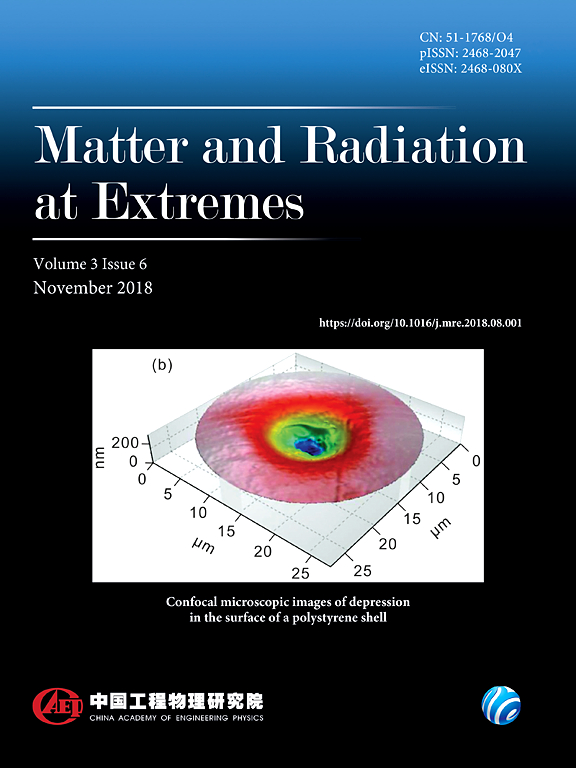金属氧中不同的振动特征和复杂的相行为
IF 4.7
1区 物理与天体物理
Q1 PHYSICS, MULTIDISCIPLINARY
引用次数: 0
摘要
浓氧中金属化的证据已经报道了 30 多年[Desgreniers 等人,J. Phys. Chem. 94, 1117 (1990)],当时的压力为 95 GPa [Shimizu 等人,Nature 393, 767 (1998)]。然而,尽管这一成果历久弥新,技术也在不断进步,但金属相的性质仍然没有得到很好的解释[Akahama 等人,Phys.74, 4690 (1995);Goncharov 等人,Phys. Rev. B 68, 224108 (2003);Ma, Phys. Rev. B 76, 064101 (2007);以及 Weck 等人,Phys.102, 255503 (2009)].在这项工作中,我们通过拉曼光谱报告了金属 ζ-O2 在 85 至 225 GPa 范围内的独特振动特性。通过与数值模拟进行比较,我们发现在大约 150 GPa 的范围内,金属 ζ-O2 与 C2/m 候选结构非常吻合。在更高的压力下,我们发现 C2/m 结构不稳定,与实验观测结果不符。我们发现在原始单胞中只有两个分子的另一种候选结构 C2/c 和 Ci 是稳定的,并且与 175 GPa 以上的测量结果更加吻合,这表明 (O2)4 单元发生了解离。此外,我们还报告并讨论了前驱相ϵ-O2 的强烈滞后性和可转移性。这些发现将重振浓氧系统的实验和理论研究,对地球深部普遍存在的含氧化学以及基础物理学具有重要意义。本文章由计算机程序翻译,如有差异,请以英文原文为准。
Distinct vibrational signatures and complex phase behavior in metallic oxygen
Evidence for metallization in dense oxygen has been reported for over 30 years [Desgreniers et al., J. Phys. Chem. 94, 1117 (1990)] at a now routinely accessible 95 GPa [Shimizu et al., Nature 393, 767 (1998)]. However, despite the longevity of this result and the technological advances since, the nature of the metallic phase remains poorly constrained [Akahama et al., Phys. Rev. Lett. 74, 4690 (1995); Goncharov et al., Phys. Rev. B 68, 224108 (2003); Ma, Phys. Rev. B 76, 064101 (2007); and Weck et al., Phys. Rev. Lett. 102, 255503 (2009)]. In this work, through Raman spectroscopy, we report the distinct vibrational characteristics of metallic ζ-O2 from 85 to 225 GPa. In comparison with numerical simulations, we find reasonable agreement with the C2/m candidate structure up to about 150 GPa. At higher pressures, the C2/m structure is found to be unstable and incompatible with experimental observations. Alternative candidate structures, C2/c and Ci, with only two molecules in the primitive unit cell, are found to be stable and more compatible with measurements above 175 GPa, indicative of the dissociation of (O2)4 units. Further, we report and discuss a strong hysteresis and metastability with the precursory phase ϵ-O2. These findings will reinvigorate experimental and theoretical work into the dense oxygen system, which will have importance for oxygen-bearing chemistry, prevalent in the deep Earth, as well as fundamental physics.
求助全文
通过发布文献求助,成功后即可免费获取论文全文。
去求助
来源期刊

Matter and Radiation at Extremes
Physics and Astronomy-Atomic and Molecular Physics, and Optics
CiteScore
8.60
自引率
9.80%
发文量
160
审稿时长
15 weeks
期刊介绍:
Matter and Radiation at Extremes (MRE), is committed to the publication of original and impactful research and review papers that address extreme states of matter and radiation, and the associated science and technology that are employed to produce and diagnose these conditions in the laboratory. Drivers, targets and diagnostics are included along with related numerical simulation and computational methods. It aims to provide a peer-reviewed platform for the international physics community and promote worldwide dissemination of the latest and impactful research in related fields.
 求助内容:
求助内容: 应助结果提醒方式:
应助结果提醒方式:


